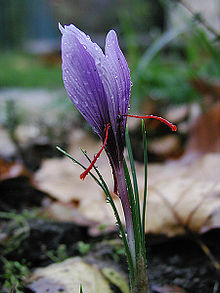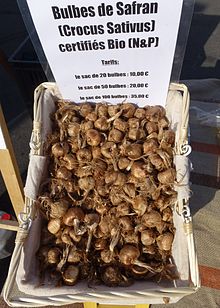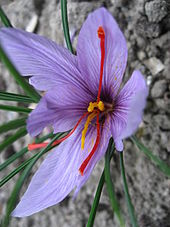 |
|
|
|
|
| Cuisines | Herbal | Spice | Curry | Yeast | Recipe | ||||||
|
Saffron Saffron (pronounced /ˈsæfrɒn/) is a spice derived from the flower of Crocus sativus, commonly known as the saffron crocus. Crocus is a genus in the family Iridaceae. Each saffron crocus grows to 20–30 cm (8–12 in) and bears up to four flowers, each with three vivid crimson stigmas, which are each the distal end of a carpel. Together with the styles, or stalks that connect the stigmas to their host plant, the dried stigmas are used mainly in various cuisines as a seasoning and colouring agent. Saffron, long among the world's most costly spices by weight, is native to Southwest Asia and was first cultivated in Greece. As a genetically monomorphic clone, it was slowly propagated throughout much of Eurasia and was later brought to parts of North Africa, North America, and Oceania. The saffron crocus, unknown in the wild, likely descends from Crocus cartwrightianus, which originated in Crete or Central Asia; C. thomasii and C. pallasii are other possible precursors. The saffron crocus is a triploid that is "self-incompatible" and male sterile; it undergoes aberrant meiosis and is hence incapable of independent sexual reproduction—all propagation is by vegetative multiplication via manual "divide-and-set" of a starter clone or by interspecific hybridisation. If C. sativus is a mutant form of C. cartwrightianus, then it may have emerged via plant breeding, which would have selected for elongated stigmas, in late Bronze-Age Crete. Saffron's bitter taste and iodoform- or hay-like fragrance result from the chemicals picrocrocin and safranal. It also contains a carotenoid dye, crocin, which imparts a rich golden-yellow hue to dishes and textiles. Its recorded history is attested in a 7th-century BC Assyrian botanical treatise compiled under Ashurbanipal, and it has been traded and used for over four millennia. Iran now accounts for approximately 90 percent of the world production of saffron. Because each flower's stigmas need to be collected by hand and there are only a few per flower, saffron is the most expensive spice in the world. DescriptionThe domesticated saffron crocus, Crocus sativus, is an autumn-flowering perennial plant unknown in the wild. Its progenitors are possibly the eastern Mediterranean autumn-flowering Crocus cartwrightianus, which is also known as "wild saffron" and originated in Central Asia. The saffron crocus likely resulted when C. cartwrightianus was subjected to extensive artificial selection by growers seeking longer stigmas. C. thomasii and C. pallasii are other possible sources. It is a sterile triploid form, which means that three homologous sets of chromosomes compose each specimen's genetic complement; C. sativus bears eight chromosomal bodies per set, making for 24 in total. Being sterile, the purple flowers of Crocus sativus fail to produce viable seeds; reproduction hinges on human assistance: corms, underground bulb-like starch-storing organs, must be dug up, broken apart, and replanted. A corm survives for one season, producing via this vegetative division up to ten "cormlets" that can grow into new plants in the next season. The compact corms are small brown globules that can measure as large as 5 centimetres (2.0 in) in diameter, have a flat base, and are shrouded in a dense mat of parallel fibres; this coat is referred to as the "corm tunic". Corms also bear vertical fibres, thin and net-like, that grow up to 5 cm above the plant's neck. The plant grows to a height of 20–30 cm (8–12 in), and sprouts 5–11 white and non-photosynthetic leafs known as cataphylls. They are membrane-like structures that cover and protect the crocus's 5–11 true leaves as they bud and develop. The latter are thin, straight, and blade-like green foliage leaves, which are 1–3 mm in diameter, either expand after the flowers have opened ("hysteranthous") or do so simultaneously with their blooming ("synanthous"). C. sativus cataphylls are suspected by some to manifest prior to blooming when the plant is irrigation relatively early in the growing season. Its floral axes, or flower-bearing structures, bear bracteoles, or specialised leaves that sprout from the flower stems; the latter are known as pedicels. After aestivating in spring, the plant sends up its true leaves, each up to 40 cm (16 in) in length. In autumn, purple buds appear. Only in October, after most other flowering plants have released their seeds, do its brilliantly hued flowers develop; they range from a light pastel shade of lilac to a darker and more striated mauve. Upon flowering, plants average less than 30 cm (12 in) in height. A three-pronged style emerges from each flower. Each prong terminates with a vivid crimson stigma 25–30 mm (0.98–1.2 in) in length. CultivationCrocus sativus thrives in the Mediterranean maquis, an ecotype superficially resembling the North American chaparral, and similar climates where hot and dry summer breezes sweep semi-arid lands. It can nonetheless survive cold winters, tolerating frosts as low as −10 °C (14 °F) and short periods of snow cover. Irrigation is required if grown outside of moist environments such as Kashmir, where annual rainfall averages1,000–1,500 mm (39–59 in); saffron-growing regions in Greece (500 mm or 20 in annually) and Spain (400 mm or 16 in) are far drier than the main cultivating Iranian regions. What makes this possible is the timing of the local wet seasons; generous spring rains and drier summers are optimal. Rain immediately preceding flowering boosts saffron yields; rainy or cold weather during flowering promotes disease and reduces yields. Persistently damp and hot conditions harm the crops, and rabbits, rats, and birds cause damage by digging up corms. Nematodes, leaf rusts, and corm rot pose other threats. Yet Bacillus subtilis inoculation may provide some benefit to growers by speeding corm growth and increasing stigma biomass yield. The plants fare poorly in shady conditions; they grow best in full sunlight. Fields that slope towards the sunlight are optimal (i.e., south-sloping in the Northern Hemisphere). Planting is mostly done in June in the Northern Hemisphere, where corms are lodged 7–15 cm (2.8–5.9 in) deep; its roots, stems, and leaves can develop between October and February. Planting depth and corm spacing, in concert with climate, are critical factors in determining yields. Mother corms planted deeper yield higher-quality saffron, though form fewer flower buds and daughter corms. Italian growers optimise thread yield by planting 15 cm (5.9 in) deep and in rows 2–3 cm (0.79–1.2 in) apart; depths of 8–10 cm (3.1–3.9 in) optimise flower and corm production. Greek, Moroccan, and Spanish growers employ distinct depths and spacings that suit their locales. C. sativus prefers friable, loose, low-density, well-watered, and well-drained clay-calcareous soils with high organic content. Traditional raised beds promote good drainage. Soil organic content was historically boosted via application of some 20–30 tonnes of manure per hectare. Afterwards, and with no further manure application, corms were planted. After a period of dormancy through the summer, the corms send up their narrow leaves and begin to bud in early autumn. Only in mid-autumn do they flower. Harvests are by necessity a speedy affair: after blossoming at dawn, flowers quickly wilt as the day passes. All plants bloom within a window of one or two weeks. Roughly 150 flowers together yield but 1 g (0.035 oz) of dry saffron threads; to produce 12 g (0.42 oz) of dried saffron (or 72 g (2.5 oz) moist and freshly harvested), 1 kg (2.2 lb) of flowers are needed; 1 lb (0.45 kg) yields 0.2 oz (5.7 g) of dried saffron. One freshly picked flower yields an average 30 mg (0.0011 oz) of fresh saffron or 7 mg (0.00025 oz) dried. ChemistrySaffron contains more than 150 volatile and aroma-yielding compounds. It also has many nonvolatile active components, many of which are carotenoids, including zeaxanthin, lycopene, and various α- and β-carotenes. However, saffron's golden yellow-orange colour is primarily the result of α-crocin. This crocin is trans-crocetin di-(β-D-gentiobiosyl) ester; it bears the systematic (IUPAC) name 8,8-diapo-8,8-carotenoic acid. This means that the crocin underlying saffron's aroma is a digentiobiose ester of the carotenoid crocetin. Crocins themselves are a series of hydrophilic carotenoids that are either monoglycosyl or diglycosyl polyene esters of crocetin. Crocetin is a conjugated polyene dicarboxylic acid that is hydrophobic, and thus oil-soluble. When crocetin is esterified with two water-soluble gentiobioses, which are sugars, a product results that is itself water-soluble. The resultant α-crocin is a carotenoid pigment that may comprise more than 10% of dry saffron's mass. The two esterified gentiobioses make α-crocin ideal for colouring water-based and non-fatty foods such as rice dishes. The bitter glucoside picrocrocin is responsible for saffron's flavour. Picrocrocin (chemical formula: C16H26O7; systematic name: 4-(β-D-glucopyranosyloxy)-2,6,6- trimethylcyclohex-1-ene-1-carboxaldehyde) is a union of an aldehyde sub-element known as safranal (systematic name: 2,6,6-trimethylcyclohexa-1,3-diene-1-carboxaldehyde) and a carbohydrate. It has insecticidal and pesticidal properties, and may comprise up to 4% of dry saffron. Picrocrocin is a truncated version of the carotenoid zeaxanthin that is produced via oxidative cleavage, and is the glycoside of the terpene aldehyde safranal. The reddish-coloured zeaxanthin is, incidentally, one of the carotenoids naturally present within the retina of the human eye. When saffron is dried after its harvest, the heat, combined with enzymatic action, splits picrocrocin to yield D–glucose and a free safranal molecule. Safranal, a volatile oil, gives saffron much of its distinctive aroma. Safranal is less bitter than picrocrocin and may comprise up to 70% of dry saffron's volatile fraction in some samples. A second element underlying saffron's aroma is 2-hydroxy-4,4,6-trimethyl-2,5-cyclohexadien-1-one, the scent of which has been described as "saffron, dried hay like". Chemists found this to be the most powerful contributor to saffron's fragrance despite its being present in a lesser quantity than safranal. Dry saffron is highly sensitive to fluctuating pH levels, and rapidly breaks down chemically in the presence of light and oxidizing agents. It must therefore be stored away in air-tight containers in order to minimise contact with atmospheric oxygen. Saffron is somewhat more resistant to heat. Grades Saffron is graded via laboratory measurement of crocin (colour), picrocrocin (taste), and safranal (fragrance) content. Determination of non-stigma content ("floral waste content") and other extraneous matter such as inorganic material ("ash") are also key. Grading standards are set by the International Organization for Standardization, a federation of national standards bodies. ISO 3632 deals exclusively with saffron and establishes four empirical colour intensity grades: IV (poorest), III, II, and I (finest quality). Samples are assigned grades by gauging the spice's crocin content, revealed by measurements of crocin-specific spectroscopic absorbance. Graders measure absorbances of 440-nm light by dry saffron samples. Higher absorbances imply greater crocin concentration, and thus a greater colourative intensity. These data are measured through spectrophotometry reports at certified testing laboratories worldwide. These colour grades proceed from grades with absorbances lower than 80 (for all category IV saffron) up to 190 or greater (for category I). The world's finest samples (the selected most red-maroon tips of stigmas picked from the finest flowers) receive absorbance scores in excess of 250. Market prices for saffron types follow directly from these ISO scores. However, many growers, traders, and consumers reject such lab test numbers. They prefer a more holistic method of sampling batches of thread for taste, aroma, pliability, and other traits in a fashion similar to that practised by practised wine tasters. Despite such attempts at quality control and standardisation, an extensive history of saffron adulteration—particularly among the cheapest grades—continues into modern times. Adulteration was first documented in Europe's Middle Ages, when those found selling adulterated saffron were executed under the Safranschou code. Typical methods include mixing in extraneous substances like beets, pomegranate fibres, red-dyed silk fibres, or the saffron crocus's tasteless and odourless yellow stamens. Other methods included dousing saffron fibres with viscid substances like honey or vegetable oil. However, powdered saffron is more prone to adulteration, with turmeric, paprika, and other powders used as diluting fillers. Adulteration can also consist of selling mislabelled mixes of different saffron grades. Thus, in India, high-grade Kashmiri saffron is often sold and mixed with cheaper Iranian imports; these mixes are then marketed as pure Kashmiri saffron, a development that has cost Kashmiri growers much of their income. Varieties The various saffron crocus cultivars give rise to thread types that are often regionally distributed and characteristically distinct. Varieties from Spain, including the tradenames "Spanish Superior" and "Creme", are generally mellower in colour, flavour, and aroma; they are graded by government-imposed standards. Italian varieties are slightly more potent than Spanish; the most intense varieties tend to be Iranian. Various "boutique" crops are available from New Zealand, France, Switzerland, England, the United States, and other countries, some of them organically grown. In the U.S., Pennsylvania Dutch saffron—known for its "earthy" notes—is marketed in small quantities. Consumers may regard certain cultivars as "premium" quality. The "Aquila" saffron, or zafferano dell'Aquila, is defined by high safranal and crocin content, distinctive thread shape, unusually pungent aroma, and intense colour; it is grown exclusively on eight hectares in the Navelli Valley of Italy's Abruzzo region, near L'Aquila. It was first introduced to Italy by a Dominican monk from Inquisition-era Spain. But the biggest saffron cultivation in Italy is in San Gavino Monreale, Sardinia, where it is grown on 40 hectares, representing 60% of Italian production; it too has unusually high crocin, picrocrocin, and safranal content. Another is the "Mongra" or "Lacha" saffron of Kashmir (Crocus sativus 'Cashmirianus'), which is among the most difficult for consumers to obtain. Repeated droughts, blights, and crop failures in the Indian-controlled areas of Kashmir combine with an Indian export ban to contribute to its prohibitive overseas prices. Kashmiri saffron is recognisable by its dark maroon-purple hue; it among the world's darkest, which hints at strong flavour, aroma, and colourative effect. UseSaffron's aroma is often described by connoisseurs as reminiscent of metallic honey with grassy or hay-like notes, while its taste has also been noted as hay-like and sweet. Saffron also contributes a luminous yellow-orange colouring to foods. Saffron is widely used in Indian, Persian and European cuisines. Sometimes Saffron is also used in Arab and Turkish cuisines as well. Confectioneries and liquors also often include saffron. Common saffron substitutes include safflower (Carthamus tinctorius, which is often sold as "Portuguese saffron" or "açafrão"), annatto, and turmeric (Curcuma longa). Saffron has also been used as a fabric dye, particularly in China and India, and in perfumery. It is used for religious purposes in India, and is widely used in cooking in many cuisines, ranging from the Milanese risotto of Italy to the bouillabaisse of France to the biryani with various meat accompaniments in South Asia. Saffron has a long medicinal history as part of traditional healing; several modern research studies have hinted that the spice has possible anticarcinogenic (cancer-suppressing), anti-mutagenic (mutation-preventing), immunomodulating, and antioxidant-like properties. Saffron stigmas, and even petals, may be helpful for depression. Early studies show that saffron may protect the eyes from the direct effects of bright light and retinal stress apart from slowing down macular degeneration and retinitis pigmentosa. (Most saffron-related research refers to the stigmas, but this is often not made explicit in research papers.) Other controlled research studies have indicated that saffron may have many potential medicinal properties. |











